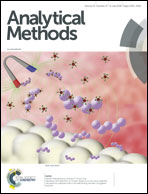Separation and detection of mutans streptococci by using magnetic nanoparticles stabilized with a cell wall binding domain-conjugated polymer†
Abstract
A number of salivary mutans streptococci (MS: Streptococcus mutans and Streptococcus sobrinus) are used in dental caries risk assessment. In this study, a simple, yet effective assay was developed for MS detection. Magnetic nanoparticles (MNPs) were first grafted with poly(acrylic acid) that bears active carboxyl groups available for conjugation with the cell wall binding domain (CWBD) of automutanolysin which specifically binds to MS. The binding efficiency of CWBD-conjugated MNPs to MS was tested with pure cultures of streptococcal standard strains. After mixing CWBD-conjugated MNPs with culture, bacteria-bound particles were separated from unbound cells using a magnet and filtered through a cellulose acetate membrane (pore-size 0.8 μm). The color intensity of particles remaining on the membrane represents the number of bound bacteria. The CWBD-conjugated MNPs showed higher efficiency in binding to S. mutans and S. sobrinus than to non-mutans streptococci (S. sanguinis and S. salivarius) with capture efficiencies of 77 and 69% for MS and 38 and 15% for non-MS. Moreover, this method can quantify the number of MS in the range of 102 to 107 colony-forming units (CFU) mL−1, which covers the range of MS levels used in caries risk assessment. The calculated limit of detection of the assay was 16 and 72 CFU mL−1 for S. mutans and S. sobrinus, respectively. Furthermore, the CWBD-conjugated MNPs could be used to efficiently quantify the number of MS in human saliva samples containing highly complex mixtures of bacterial species. These results suggest that the assay could be applicable as a simple tool for MS determination in not only clinical settings but also community fields without clinical expert requirement.



 Please wait while we load your content...
Please wait while we load your content...